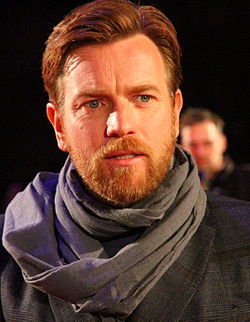Critical response
The prequel trilogy received mixed reviews, generally improving in critical reception with each installment. Common criticisms surrounded the over-reliance on computer-generated imagery, wooden dialogue (including scenes of romance between Anakin and Padmé), slow-paced political scenes, [56] [57] [58] and the comic relief character of Jar Jar Binks, whose role was reduced after the first film. [59] [f] Several alien characters introduced in The Phantom Menace have been subject to accusations of racial stereotypes. Jar Jar is asserted to caricature a stereotyped Jamaican, [61] [62] while the Gungan species at large has been said to suggest a primitive African tribe. [59] The greedy Neimoidians of the Trade Federation have been noted as resembling East Asian stereotypes [63] with some deliberately given Thai accents, [64] and Watto's mannerisms and hooked nose appearance were based on footage of Alec Guinness as the Jewish character Fagin in the 1948 film Oliver Twist , [65] leading some to assert that the slave-owning character is a Jewish stereotype. [66] Lucas denied all accusations of racial stereotypes. [59] [67]
Many expressed their disappointment with the trilogy's portrayal of Anakin Skywalker, particularly calling the writing weak and the dialogue wooden, [56] although Hayden Christensen's performance in the third film was more well received. [68] Contrarily, Ewan McGregor's portrayal of Obi-Wan Kenobi, following in the footsteps of Alec Guinness, has been generally praised. [69] Natalie Portman has expressed her disappointment with the trilogy's negative reception, saying that "When something has that much anticipation it can almost only disappoint". She also acknowledged that "With the perspective of time, it's been re-evaluated by a lot of people who actually really love them now". [70]
The trilogy has also received some criticism for clashing aesthetically with the original trilogy. While the older films feature rough and aged technology, the prequels depict relatively sleek and new industrial designs. [56] Some have criticized this design choice by saying that it makes the earlier time period appear to depict a more advanced civilization, although Revenge of the Sith brings the design closer to that of the original trilogy. [71] Lucas has called the choice clever, as it illustrates the halt of technological innovation in a time period of civil war. [72]
Conversely, some argue for the prequel trilogy's positive elements, including its handling of political issues, especially involving the rise of fascism. [56] This includes Star Wars: The Last Jedi director and writer Rian Johnson, who also praised its visual effects innovations. Jar Jar Binks has been regarded as the first fully CGI character in a live-action film, and perceived as paving the way for Gollum in The Lord of the Rings . [73] [74] KING-TV's Kelly Lawler complimented the lightsaber battles as "sleeker affairs with better choreography and more athleticism" compared to the original trilogy. [56] J. J. Abrams praised the acting of Ian McDiarmid as Darth Sidious, stating that the scene where he recounts the tragedy of Darth Plagueis is the best of the trilogy. [75]
George Lucas has responded to the negative criticism by saying that, like the original films, they were intended "for 12-year-olds", while acknowledging that fans who saw the originals when they were young had different expectations as adults. [1] [76] The prequels have been noted as retaining a dedicated fanbase, primarily composed of Millennials [77] and Gen Zers [78] who were children at the time of their release. [79] [80] Since the late 2010s, the prequels have amassed a cult following via Internet memes on social media, [80] with Neel Patel of Syfy Wire attributing this to the internet being a "paradise of irreverence, just like George Lucas' scripts". [81] Additionally, both the animated series Star Wars: The Clone Wars and Disney's sequel trilogy has been noted to have retroactively improved the perception of the prequel trilogy among fans. [58] [79] [82]
Screen Rant favorably compared the way the prequels ended the saga compared to the sequels, writing, "Amidst the bad execution of the story, the fact of the matter is, the prequel movies tell one coherent narrative, with a clear through-line between movies – this is something sorely lacking in the sequel trilogy". [83] Similarly, Den of Geek's Andrew Blair wrote that the prequels were "enjoying a deserved reappraisal" following vocal discourse surrounding the sequels. He considered the prequels to be the superior trilogy as, in contrast to its successors, the films had "consistency" and "the product of a singular vision". [79]


